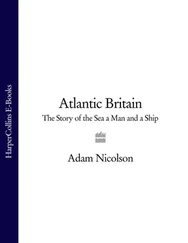Henry Field - The Story of the Atlantic Telegraph
Здесь есть возможность читать онлайн «Henry Field - The Story of the Atlantic Telegraph» — ознакомительный отрывок электронной книги совершенно бесплатно, а после прочтения отрывка купить полную версию. В некоторых случаях можно слушать аудио, скачать через торрент в формате fb2 и присутствует краткое содержание. Жанр: foreign_antique, foreign_prose, на английском языке. Описание произведения, (предисловие) а так же отзывы посетителей доступны на портале библиотеки ЛибКат.
- Название:The Story of the Atlantic Telegraph
- Автор:
- Жанр:
- Год:неизвестен
- ISBN:нет данных
- Рейтинг книги:3 / 5. Голосов: 1
-
Избранное:Добавить в избранное
- Отзывы:
-
Ваша оценка:
- 60
- 1
- 2
- 3
- 4
- 5
The Story of the Atlantic Telegraph: краткое содержание, описание и аннотация
Предлагаем к чтению аннотацию, описание, краткое содержание или предисловие (зависит от того, что написал сам автор книги «The Story of the Atlantic Telegraph»). Если вы не нашли необходимую информацию о книге — напишите в комментариях, мы постараемся отыскать её.
The Story of the Atlantic Telegraph — читать онлайн ознакомительный отрывок
Ниже представлен текст книги, разбитый по страницам. Система сохранения места последней прочитанной страницы, позволяет с удобством читать онлайн бесплатно книгу «The Story of the Atlantic Telegraph», без необходимости каждый раз заново искать на чём Вы остановились. Поставьте закладку, и сможете в любой момент перейти на страницу, на которой закончили чтение.
Интервал:
Закладка:
"In little more than ten miles of distance a change of depth occurs, amounting to seventy-two hundred feet." This is indeed a tremendous plunge from the hard rock into the slime of the sea.
The same sharp declivity was noticed by Berryman, and has been observed in the several attempts to lay the cable. Thus in the second expedition of 1858, as the Agamemnon was approaching the coast of Ireland, we read in the report of her voyage: "About five o'clock in the evening, the steep submarine mountain which divides the telegraphic plateau from the Irish coast, was reached; and the sudden shallowing of the water had a very marked effect on the cable, causing the strain on, and the speed of it, to lessen every minute. A great deal of slack was paid out to allow for inequalities which might exist, though undiscovered by the sounding-line."
This submarine mountain was then regarded as the chief point of danger in the whole bed of the Atlantic, and as the principal source of anxiety in laying a cable across the ocean. Yet, after all, the ascent or descent of less than a mile and a half in ten miles, is not an impassable grade. More recent soundings reduce this still farther. Captain Hoskins, of the Royal Navy, afterwards made a more careful survey of this precipitous sea bottom, and with results much more favorable. The side of the mountain, it is now said, is not very much steeper than Holborn Hill in London, or Murray Hill in New York. 9 9 The results obtained are thus summed up in the London Times: "The dangerous part of this course has hitherto been supposed to be the sudden dip or bank which occurs off the west coast of Ireland, where the water was supposed to deepen in the course of a few miles from about three hundred fathoms to nearly two thousand. Such a rapid descent has naturally been regarded with alarm by telegraphic engineers, and this alarm has led to a most careful sounding survey of the whole supposed bank by Captain Dayman, acting under the instructions of the Admiralty. The result of this shows that the supposed precipitous bank, or submarine cliff, is a gradual slope of nearly sixty miles. Over this long slope the difference between its greatest height and greatest depth is only eighty-seven hundred and sixty feet; so that the average incline is, in round numbers, about one hundred and forty-five feet per mile. A good gradient on a railway is now generally considered to be one in one hundred feet, or about fifty-three in a mile; so that the incline on this supposed bank is only about three times that of an ordinary railway. In fact, as far as soundings can demonstrate any thing, there are few slopes in the bed of the Atlantic as steep as that of Holborn Hill. In no part is the bottom rocky, and with the exception of a few miles, which are shingly, only ooze, mud, or sand is to be found."
But the best answer to fears on this point, is the fact that in 1857, 1858, and 1865, the cable passed over it without difficulty. In 1857 the Niagara was a hundred miles farther to sea, when the cable broke. In 1865 the strain was not increased more than a hundred pounds. In the final expedition, that of 1866, this declivity was passed over without difficulty or danger.
Next to the depth of the ocean, it was important to ascertain the nature of its bottom. What was it – a vast bed of rock, the iron-bound crust of the globe, hardened by internal fires, and which, bending as a vault over the still glowing centre of the earth, bore up on its mighty arches the weight of all the oceans? or was it mere sand like the sea-shore? or ooze as soft as that of a mill-pond? The pressure of a column of water two miles high would be equal to that of four hundred atmospheres. Would not this weight alone be enough to crush any substance that could reach that tremendous depth? These were questions which remained to be answered, but on which depended the possibility of laying a cable at the bottom of the Atlantic.
By the ingenious contrivance of Lieutenant Brooke, the problem was solved, for we got hold of fragments of the under-coating of the sea; and to our amazement, instead of finding the ocean bound round with thick ribs of granite, its inner lining was found to be soft as a silken vest. The soil brought up from the bottom was not even of the hardness of sand or gravel. It was mere ooze, like that of our rivers, and was as soft as the moss that clings to old, damp stones on the river's brink. At first it was thought by Lieutenant Berryman to be common clay, but being carefully preserved, and subjected to a powerful microscope, it was found to be composed of shells, too small to be discovered by the naked eye!
This was a revelation of the myriad forms of animated existence which fill the sea: a plenitude of life that is more wonderful by contrast. As Maury well puts it: "The ocean teems with life, we know. Of the four elements of the old philosophers – fire, earth, air, and water – perhaps the sea most of all abounds with living creatures. The space occupied on the surface of our planet by the different families of animals and their remains are inversely as the size of the individual. The smaller the animal, the greater the space occupied by his remains. Take the elephant and his remains, or a microscopic animal and his, and compare them. The contrast, as to space occupied, is as striking as that of the coral reef or island with the dimensions of the whale. The graveyard that would hold the corallines is larger than the graveyard that would hold the elephants."3
These little creatures, whose remains were thus found at the bottom of the ocean, probably did not live there, for there all is dark, and shells, like flowers, need the light and warmth of the all-reviving sun. It was their sepulchre, but not their dwelling-place. Probably they lived near the surface of the ocean, and after their short life, sunk to the tranquil waters below. What a work of life and death had been going on for ages in the depths of the sea! Myriads upon myriads, ever since the morning of creation, had been falling like snow-flakes, till their remains literally covered the bottom of the deep.
Equally significant was the fact that these shells were unbroken . Not only were they there, but preserved in a perfect form. Organisms the most minute and delicate, fragile as drooping flowers, had yet sunk and slept uninjured. The same power which watches over the fall of a sparrow had kept these frail and tender things, and after their brief existence, had laid them gently on the bosom of the mighty mother for their eternal rest.
The bearing of this discovery on the problem of a submarine telegraph was obvious. For it too was to lie on the ocean-bed, beside and among these relics that had so long been drifting down upon the watery plain. And if these tiny shells slept there unharmed, surely an iron chord might rest there in safety. There were no swift currents down there; no rushing waves agitated that sunless sea. There the waters moved not; and there might rest the great nerve that was to pass from continent to continent. And so far as injury from the surrounding elements was concerned, there it might remain, whispering the thoughts of successive generations of men, till the sea should give up its dead.
CHAPTER VI.
THE WORK BEGUN IN ENGLAND
Up to this time the Telegraph, which was destined to pass the sea, had been purely an American enterprise. It had been begun, and for over two years had been carried on, wholly by American capital. "Our little company," said Mr. Field ten years after, "raised and expended over a million and a quarter of dollars before an Englishman paid a single pound sterling." Mr. Brett was the first one to take a few shares. But this was not to the discredit of England, for the American public had done no better. Not a dollar had been raised this side the Atlantic, outside of the little circle in which the scheme had its origin. No stock or bonds were put upon the market; no man was asked for a subscription. If they wanted money, they drew their checks for it. At one time, indeed, two hundred and fifty thousand dollars of bonds were issued, but they were at once taken wholly by themselves. But, as the time was now come when the long-meditated attempt was to be made to carry the Telegraph across the ocean, it was fitting that Great Britain, whose shores it was to touch, should join in the work. Accordingly, in the summer of 1856, after finishing all that he could do in America, Mr. Field sailed with his family for England. The very day before he embarked, he had the pleasure to see his friend, Lieutenant Berryman, off on his second voyage to make soundings across the Atlantic.
Читать дальшеИнтервал:
Закладка:
Похожие книги на «The Story of the Atlantic Telegraph»
Представляем Вашему вниманию похожие книги на «The Story of the Atlantic Telegraph» списком для выбора. Мы отобрали схожую по названию и смыслу литературу в надежде предоставить читателям больше вариантов отыскать новые, интересные, ещё непрочитанные произведения.
Обсуждение, отзывы о книге «The Story of the Atlantic Telegraph» и просто собственные мнения читателей. Оставьте ваши комментарии, напишите, что Вы думаете о произведении, его смысле или главных героях. Укажите что конкретно понравилось, а что нет, и почему Вы так считаете.












